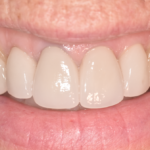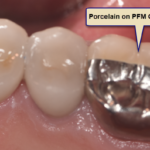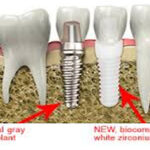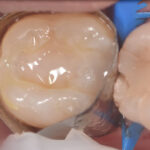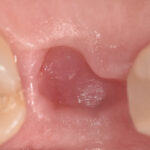This photo is of a porcelain crown seated with a newer generation dental cement made to be strong and biocompatible. Can you tell which tooth has the crown on it? It is very difficult even with a close up lens. This result is only possible when I do 3 very specific things. After years of using different porcelains, crown materials and cements, what I’m about to tell you is what works the best. The 3 steps below are mandatory if you similar results to that in the picture:
- Use the latest porcelain materials
- Use bio-friendly cosmetic bonding agents
- Take pictures with a close up lens and ring flash and send them to a high end lab for custom shading.
Let me tell you exactly what I did. This crown was made with Emax porcelain which lets the light shine through it to appear more life like and natural. Then I used a bonding agent that is tooth colored and blended it with the adjacent teeth. What I like about this cement is that it is biocompatible having no Bisphenol A (BPA) or fluoride. This is pretty much unheard of for crown cements. Most of them have BPA or fluoride or both. As you may know BPA is a homone disrupter, as it mimics estrogen in the body. Fluoride is considered toxic at fairly low levels. While the fluoride or BPA released from one crown is not enough to hurt you, it is the total exposure from all sources I am worried about. For instance, if you have many crowns and drink filtered water from plastic bottles for instance, your exposure to BPA may be higher. Why should this matter? Well, if you are not paying attention you may be getting exposed to more BPA than you realize. There are many sources of BPA, as it is used to make plastics, including the water bottles many use for their filtered water. The following may be bad news for many of you, but research has linked BPA to health conditions like:
- Reproductive disorders in women by affecting egg maturation
- Heart disease in all adults, but particularly women
- Changes is sex hormones in men
- Type 2 diabetes
- Brain function and learning
- Breast cancer
- Asthma
I’ve noticed that a certain percentage of my patients seem to be affected by dental materials. Why not be safe and use materials that have been shown to be more biocompatible? Eliminate BPA, fluoride, mercury and in fact all metals when possible. More on other dental materials and metals in a later post.

Carey O’Rielly DDS has been a practicing dentist for 35 years. He went to USC Dental School and Duke University for his undergraduate degree. He grew up in Laguna Beach and now lives in La Costa with his wife Victoria, who runs his office.
He began his career by owning and operating a network of six offices in the San Francisco Bay Area. Presently he owns a private holistic practice in North County San Diego’s Encinitas.
Dr. O started looking for solutions to his health challenges that resulted from the stress and environmental toxicity that built up over a ten year period running his dental network. He has dedicated himself to learning about oral systemic problems and how dentistry can affect your health. He has applied what he has learned over the last twenty years to ensure he, his staff and his patients are protected from the chemicals and toxic materials found in most dental offices. He has produced an environmentally friendly office that is also peaceful and calm.
He is an expert on dental materials having looked at hundreds of biocompatibility lab tests over the years. He has identified the most bio-friendly materials to use in his practice and which dental materials can be used to replace metal fillings and crowns, including BPA free and fluoride free ‘white’ fillings. He also uses metal-free Zirconia or ceramic implants and PRF (platelet-rich fibrin) grafting materials which come from the patient’s own blood.
Dr. O’Rielly teaches C.E. courses on the systemic effects of gum disease. He is an expert in using phase contrast microscopy for analyzing dental infections, where he shows patients what kind of microbes, i.e. bacteria, amoeba, and yeasts like candida are populating the mouth and affecting the body as a whole.
He has an educational blog and is writing a book on dental health called ‘Hidden Dental Infections: Healing Root Canals and Infected Teeth with the Erbium Laser’ where he discusses dental nutrition, toxic dental materials and the effects of old root canals on inflammation and overall health.


